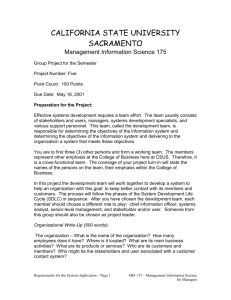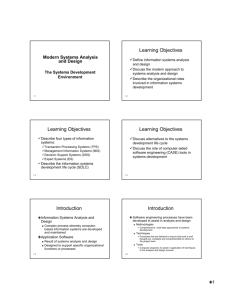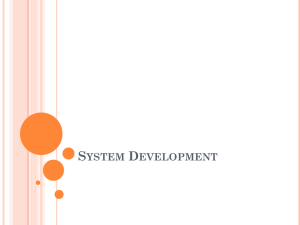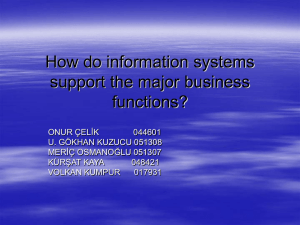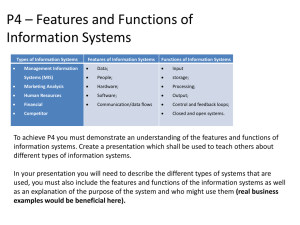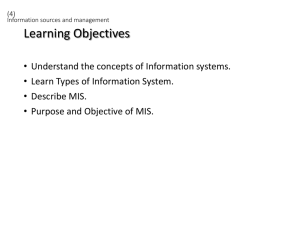Slides
advertisement
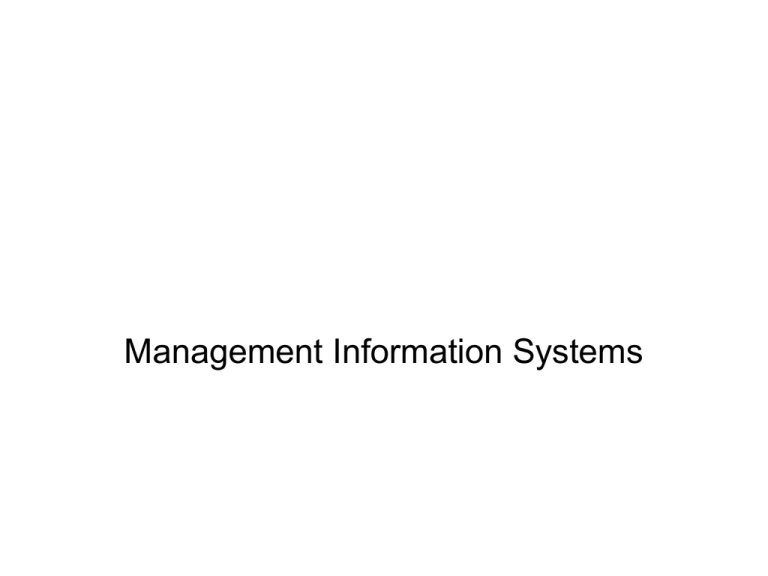
Management Information Systems Topics • • • • • • • Information Systems Evolution & Types of Information Systems MIS, DSS, ESS Expert System The concept of Data and Information SDLC (System development Life Cycle) Structured Analysis Design and Implementation. Raw facts of Information Systems • People, hardware, software, data, network resources, and organization. • Information products that are produced. • The way input, processing, output, storage, and control activities performed. Information Systems • Information system can be defined as an organizational and management solution, based on information and communication technology, to a challenge posed by the environment. • Information systems can be defined technically as a set of interrelated components that collect, process, store, retrieve, and distribute information to support communication, decision making, co-ordination and control, problem solving, negotiation and even socialization in an organization. Component of IS What the system tries to accomplish Information Goals What the system tries to accomplish How work is performed by people and technology Work Practices People Information Technology Formatted Text, data, pictures, sound People who handle data, make decisions Hardware and software that process data Therefore… An information system is “ an integrated man/machine system for providing information to support operations, management and decision making in an organization. The system is composed of HW, SW, manual procedures, management and decision models” OR “ IS can be any organized combination of people, hardware, software, communication networks, and data resources that stores and retrieve, transforms, and disseminates information in an organization” The three fundamental roles of IS in Business • Support of its business processes and operations. • Support of decision making by its employees and managers. • Support of its strategies for competitive advantage. – Objectives of Information Systems : • Essentially these can be seen as the benefits that an organization can achieve through the successful use of an Information System • Efficient Operations – maximization of throughput with respect to the unit of resource input – the organization obtains maximum benefit with the least waste from the resources it allocates to tasks • Effective Management – the ability to produce the intended output in a satisfactory manner – a measure of how well the products and/or services of an organization meet customer needs • Competitive Advantage – first use I.T. to produce information to make the operational and management activities of the business efficient and effective (as above) – next use information in new and innovative ways to improve business performance, cut costs, etc. to develop an advantage in comparison to competitors • Long-Term Goals – – – – – – Survival Profitability Expansion Market Share Customer Satisfaction Employee Satisfaction Evolution of IS • Data processing: 1950s-1960s (Role of IS was simple: transaction processing, record keeping, accounting, and other EDP applications.) • Management Reporting: 1960s-1970s (MIS role was added- Management Reports). • Decision Support: 1970s-1980s (Decision support systems) • Strategic and End user support: 1980s1990s (End user computing systems, Executive Information systems, Expert systems, Strategic Information System) • Electronic Business and Commerce :1990’s-2000s (Internet based e-business and e-commerce systems- internet, intranet and extranet) Types of IS Operations and Management classifications of IS Information Systems Operation Support Systems Transaction Processing Systems Process Control Systems Management Support Systems Enterprise Collaboration System MIS DSS ESS Management Information Systems • When information system applications focus on providing information and support for effective decision making by managers, they are called management support systems. • Management Information systems (MIS) provide information in form of reports and displays to managers and many business professionals. Management Information System (MIS): Management level • Inputs: High volume data • Processing: Simple statistical models • Outputs: Summary reports • Users: Middle managers Example: Sales Result • Decision-Support Systems (DSS) – As MIS, these serve the needs of the management level of the organisation – Focus on helping managers make decisions that are semi-structured, unique, or rapidly changing, and not easily specified in advance – Use internal information from TPS and MIS, but also information from external sources – Greater analytical power than other systems, incorporate modelling tools, aggregative and analysis tools, and support what-if scenarios – Must provide user-friendly, interactive tools • Expert Systems: Knowledge-based systems that provide expert advice and act as expert consultant to users. • Performs tasks that would be done by a human. • Example Medical Diagnostic System • Some Expert systems are empowered to make decisions and take actions. Example ES that monitors inventory levels for grocery store. The concept of Data and Information • The word data is originated from datum. • Data are raw facts or observations, typically about physical phenomena or business transactions. • Information can be defined as data that have been converted into a meaningful and useful context for specific end users. The Information Systems Development Life-Cycle (SDLC) To help create successful information system, the SDLC was developed. The SDLC is the organized way to build information system. –Feasibility Study –Systems Investigation –Systems Analysis –Systems Design –Implementation –Review & Maintenance SDLC (System Development Life Cycle) Assignment 1. How can information Systems support a company’s business processes and decision making, and give it a competitive advantage? Give examples to illustrate your answer. 2. How do manager take decisions? How is decision making process linked to operation support systems, like Transaction processing systems etc?

